Calculating the Binary Tortuosity in DEM-Generated Granular Beds
Abstract
1. Introduction
- Direct analysis of the pore channels geometry. The computational space may be expressed directly in a form of the vector geometry, or indirectly, by a grid of nodes, cells, elementary volumes, pixels, or voxels. Algorithms may have analytical origins or may be based on different discrete techniques. In this approach the tortuosity is expressed as follows [4,5],
- The analysis of transportation properties of fluids flowing through pore channels. In this approach [17,18]where is the the absolute value of local flow velocity obtained for a creeping flow, is the X-component of velocity (where X is the direction of main flow), and is a spatial average over the pore space. The tortuosity calculated with the use of Equation (4) is in the literature called the hydraulic tortuosity. If a velocity field is available, than the so-called streamline tortuosity may be also calculated [19]. Other examples of calculating the hydraulic tortuosity may be found in [20,21,22].
- The analysis of diffusional properties of porous media and the application of the following relationship [23,24],where is the effective diffusivity [m/s], D is the intrinsic diffusivity of the conductive phase [m/s], is the volume fraction of the conductive phase , and is the tortuosity factor [-] defined as the square of the tortuosity. The diffusional approach is applied, e.g., in [25,26,27].
- Preparing the geometry of a porous body with the use of any method. In the hereby paper, virtual beds generated by the use of the Discrete Element Method (Section 2.2) are applied. They represent the existing bed samples consisting of glass marbles. Such a choice was dictated by the fact that the alternative results for these bed samples are available and thus can be used as comparative data. At this stage, it is assumed that the porosity of virtual bed samples must be the same as the porosity of a real bed sample. The formulas collected in Table 1 clearly indicate that porosity is the most important factor influencing the tortuosity value.
- Converting the available vector geometry to a binary geometry.
- Calculating the path lengths (Section 3.3) and then calculating the binary tortuosity (Section 3.4) with the use of the A-Star Algorithm (Section 2.3) and the Path Searching Algorithm (Section 2.4). At this stage, it is assumed that all calculations will be repeated for three geometries (Section 3.1) and for a few different resolutions of the binary geometry (Section 3.2).
- Comparing the obtained results with other independent data as well as with the data obtained from empirical formulas collected in Table 1 (Section 3.4). At this stage, the hydraulic tortuosity, calculated with the use of the Lattice Boltzmann Method (which is also based on the geometry expressed by binary matrices), as well as the geometric tortuosity, determined by the Path Tracking Method, serve as the reference data [42]. These tortuosities were obtained for the same material as in the present study (Section 2.1). Additionally, the results obtained by Wang, who investigated tortuosity in very similar granular systems [22], are taken into account during the comparison.
2. Materials and Methods
2.1. Materials
2.2. Discrete Element Method
2.3. A-Star Algorithm
- Manhattan function
- Diagonal function
- Euklides function
- Quasi-Euklides functionwhere D is a space scale coefficient; , , and are coordinates of i-th point located adjacent to the Start Point; and , , and are coordinates of the assumed Stop Point of the path.
2.4. Path Searching Algorithm
- If the movement forward is possible (it is a so-called free node), than the path goes straight in this direction (Figure 5a). A free node means here a node located in the pore space and not belonging to the current path. In Figure 5, the main direction in which the path is determined is from the left to the right.
- If the movement forward is impossible (the next node in the main direction is not free), then the path turns at a right angle (Figure 5b). The movement is possible only to a free node. If there is more than one free node (Figure 5c), then the movement direction is drawn by the use of the random number generator.
- If the movement forward is impossible, the path cannot go perpendicular to the main direction, but the node located behind the current node is free, then the path turns back (Figure 5d).
- If no further movement is possible (such a case is called as a cavity, Figure 5e), then the path points are deleted in sequence until another free node (not used before) is found.
3. Results and Discussion
3.1. DEM Simulations
3.2. Geometry Conversion
3.3. Determination of Path Lengths
3.4. Tortuosity Calculation
4. Summary
- To obtain the same porosity as in a real bed sample, the virtual bed has to contain approximately 1000 particles.
- The resolution of the binary representation of a real (or virtual) bed cannot be too small. However, this resolution may be still much lower than the resolution of grids required by other numerical techniques, in particular by the Lattice Boltzmann Method (used by Wang [22] or in the previous investigations described in the [42]).
- It is possible to calculate tortuosity with algorithms working on a geometry saved in a form of binary matrices.
- The Path Searching Algorithm gives always higher values of the tortuosity than the A-Star Algorithm.
- The A-Star Algorithm (in both implemented variants) underestimated the tortuosity in comparison with the tortuosity (hydraulic or geometric) calculated by alternative numerical techniques.
- The Path Searching Algorithm overestimates the tortuosity in comparison with the tortuosity (hydraulic or geometric) calculated by alternative numerical techniques. However, the results are in good agreement with the values calculated with the use of empirical formulas collected in Table 1.
- The Path Searching Algorithm is about two times faster than the A-Star Algorithm.
Funding
Conflicts of Interest
References
- Sobieski, W.; Trykozko, A. Sensitivity aspects of Forchheimer’s approximation. Transp. Porous Med. 2011, 89, 155–164. [Google Scholar] [CrossRef]
- Darcy, H. Les Fontaines Publiques De La Ville De Dijon; Victor Dalmont: Paris, France, 1856. (In French) [Google Scholar]
- Forchheimer, P. Wasserbewegung durch boden. Zeit. Ver. Deutsch. Ing. 1901, 45, 1781–1788. (In German) [Google Scholar]
- Carman, P.C. Fluid Flow through a Granular Bed. Trans. Inst. Chem. Eng. Lond. 1937, 15, 150–156. [Google Scholar] [CrossRef]
- Kozeny, J. Über kapillare Leitung des Wassers im Boden; Sitzungsberichte 136/2a; Akademie der Wissenschaften: Wien, Austria, 1927; pp. 271–306. (In German) [Google Scholar]
- Ergun, S. Fluid flow through packed columns. Chem. Eng. Prog. 1952, 48, 89–94. [Google Scholar]
- Mian, M.A. Petroleum Engineering Handbook for the Practicing Engineer; Pennwell Publishing: Tulsa, OK, USA, 1992. [Google Scholar]
- Skjetne, E.; Klov, T.; Gudmundsson, J.S. High-Velocity Pressure Loss In Sandstone Fractures: Modeling And Experiments (SCA-9927). In Proceedings of the International Symposium of the Society of Core Analysts, Colorado School of Mines, Golden, CO, USA, 1–4 August 1999. [Google Scholar]
- Samsuri, A.; Sim, S.H.; Tan, C.H. An Integrated Sand Control Method Evaluation. In Proceedings of the Society of Petroleum Engineers, SPE Asia Pacific Oil and Gas Conference and Exhibition, Jakarta, Indonesia, 9–11 September 2003. [Google Scholar]
- Belyadi, A. Analysis of Single-Point Test To Determine Skin Factor. Ph.D. Thesis, Department of Petroleum and Natural Gas Engineering, West Virginia University, Morgantown, WV, USA, 2006. [Google Scholar]
- Belyadi, F. Determining Low Permeability Formation Properties from Absolute Open Flow Potential. Ph.D. Thesis, Department of Petroleum and Natural Gas Engineering, West Virginia University, Morgantown, WV, USA, 2006. [Google Scholar]
- Lord, D.L.; Rudeen, D.K.; Schatz, J.F.; Gilkey, A.P.; Hansen, C.W. DRSPALL: Spallings Model for the Waste Isolation Pilot Plant 2004 Recertification; SAND2004-0730; Sandia National Laboratories: Albuquerque, NM, USA; Livermore, CA, USA, 2006. [Google Scholar]
- Wu, Y.S.; van Vliet, L.J.; Frijlink, H.W.; van der Voort Maarschalk, K. The determination of relative path length as a measure for tortuosity in compacts using image analysis. Eur. J. Pharm. Sci. 2006, 28, 433–440. [Google Scholar] [CrossRef] [PubMed]
- Chinda, P.; Brault, P. Tortuosity Model of a Three-Dimensional Stacked Cylindrical Particles Porous Medium for Using with the Thin Film Solid Oxide Fuel Cell Electrodes. Thammasat Int. J. Sci. Technol. 2012, 17, 42–53. [Google Scholar]
- Yu, B.M.; Li, J.H. A geometry model for tortuosity of flow path in porous media. Chin. Phys. Lett. 2004, 21, 1569–1571. [Google Scholar]
- Yun, M.-J.; Yu, B.-M.; Bin, Z.; Huang, M.-T. A Geometry Model for Tortuosity of Streamtubes in Porous Media with Spherical Particles. Chin. Phys. Lett. 2005, 22, 1464. [Google Scholar]
- Koponen, A.; Kataja, M.; Timonen, J. Tortuous flow in porous media. Phys. Rev. E 1996, 54, 406–410. [Google Scholar] [CrossRef]
- Koponen, A.; Kataja, M.; Timonen, J. Permeability and effective porosity of porous media. Phys. Rev. E 1997, 56, 3319. [Google Scholar] [CrossRef]
- Matyka, M.; Khalili, A.; Koza, Z. Tortuosity-porosity relation in porous media flow. Phys. Rev. E 2008, 78, 026306. [Google Scholar] [CrossRef] [PubMed]
- Duda, A.; Koza, Z.; Matyka, M. Hydraulic tortuosity in arbitrary porous media flow. Phys. Rev. E 2011, 84, 036319. [Google Scholar] [CrossRef] [PubMed]
- Sobieski, W. Numerical investigations of tortuosity in randomly generated pore structures. Math. Comput. Simulat. 2019, 166, 20. [Google Scholar] [CrossRef]
- Wang, P. Lattice Boltzmann Simulation of Permeability and Tortuosity for Flow through Dense Porous Media. Math. Probl. Eng. 2014, 2014, 694350. [Google Scholar] [CrossRef]
- Epstein, N. On tortuosity and the tortuosity factor in flow and diffusion through porous media. Chem. Eng. Sci. 1989, 44, 777–779. [Google Scholar] [CrossRef]
- Holt, T.E.; Smith, D.M. Surface roughness effects on Knudsen diffusion. Chem. Eng. Sci. 1989, 44, 779–781. [Google Scholar] [CrossRef]
- Chou, H.; Wu, L.; Zeng, L.; Chang, A. Evaluation of solute diffusion tortuosity factor models for variously saturated soils. Water Resour. Res. 2012, 48, 11. [Google Scholar] [CrossRef]
- Cooper, S.J.; Bertei, A.; Shearing, P.R.; Kilner, J.A.; Brandon, N.P. TauFactor: An open-source application for calculating tortuosity factors from tomographic data. SoftwareX 2016, 5, 203–210. [Google Scholar] [CrossRef]
- Kong, W.; Chen, D.; Zhang, Q.; Su, S.; Zhang, J.; Gao, X. A Method for Predicting the Tortuosity of Pore Phase in Solid Oxide Fuel Cells. Electrode Int. J. Electrochem. Sci. 2015, 10, 5800–5811. [Google Scholar]
- Ahmadi, M.M.; Mohammadi, S.; Hayati, A.N. Analytical derivation of tortuosity and permeability of mono-sized spheres: A volume averaging approach. Phys. Rev. E 2011, 83, 026312. [Google Scholar] [CrossRef]
- Lanfrey, P.-Y.; Kuzeljevic, Z.V.; Dudukovic, M.P. Tortuosity model for fixed beds randomly packed with identical particles. Chem. Eng. Sci. 2010, 65, 1891–1896. [Google Scholar] [CrossRef]
- Allen, R.; Sun, S. Investigating the role of tortuosity in the Kozeny-Carman equation. In Proceedings of the International Conference on Numerical and Mathematical Modeling of Flow and Transport in Porous Media, Dubrovnik, Croatia, 29 September–3 October 2014. [Google Scholar]
- Tang, X.-W.; Sun, Z.-F.; Cheng, G.C. Simulation of the relationship between porosity and tortuosity in porous media with cubic particles. Chin. Phys. B 2012, 21, 100201. [Google Scholar] [CrossRef]
- Pearson, K. The Problem of the Random Walk. Nature 1905, 72, 294. [Google Scholar] [CrossRef]
- Nakashima, Y.; Watanabe, Y. Estimate of transport properties of porous media by microfocus X-ray computed tomography and random walk simulation. Water Resour. Res. 2002, 38, 1272. [Google Scholar] [CrossRef]
- Boudreau, B.P.; Meysman, F.J.R. Predicted tortuosity of muds. Geology 2006, 34, 693–696. [Google Scholar] [CrossRef]
- Huang, J.; Xiao, F.; Dong, H.; Yin, X. Diffusion Tortuosity in Complex Porous Media from Pore-Scale Numerical Simulations. Comput. Fluids 2019, 183, 66–74. [Google Scholar] [CrossRef]
- Amien, M.N.; Pantouw, G.T.; Juliust, H.; Dzar, F.; Latief, E. Geometric tortuosity analysis of porous medium using simple neurite tracer. In Proceedings of the IOP Conference Series: Earth and Environmental Science, Bandung, Indonesia, 2–4 July 2018; Volume 311, p. 012041. [Google Scholar]
- Simple Neurite Tracer. Available online: https://imagej.net/SNT (accessed on 1 August 2020).
- Cao, T.; Zhang, L.; Sun, G.; Wang, C.; Zhang, Y.; Yan, N.; Xu, A. Model for Predicting the Tortuosity of Transport Paths in Cement-Based Materials. Materials 2019, 12, 3623. [Google Scholar] [CrossRef]
- Bhatnagar, P.L.; Gross, E.P.; Krook, M. A Model for Collision Processes in Gases. I. Small Amplitude Processes in Charged and Neutral One-Component Systems. Phys. Rev. 1954, 94, 511–525. [Google Scholar] [CrossRef]
- Bell, M.; Trozzi, V.; Hosseinloo, S.; Gentile, G.; Fonzone, A. Time-dependent Hyperstar algorithm for robust vehicle navigation. Transp. Res. Part Policy Pract. 2012, 46, 790–800. [Google Scholar] [CrossRef]
- Opoku, D.; Homaifar, A.; Tunstel, E. The A-r-Star (Ar*) Pathfinder. Int. J. Comput. Appl. 2013, 67, 32–44. [Google Scholar] [CrossRef]
- Sobieski, W.; Matyka, M.; Gołembiewski, J.; Lipiński, S. The Path Tracking Method as an alternative for tortuosity determination in granular beds. Granul. Matter. 2018, 20, 72. [Google Scholar] [CrossRef]
- Sobieski, W.; Zech, A.; Roaff, A. Time consumption in calculations of the hydraulic and geometrical tortuosity in granular beds. Tech. Sci. 2020, 23, 25–51. [Google Scholar] [CrossRef]
- Lindner, S. Product Data Sheet. Available online: http://www.tecmos.com/wp-content/uploads/2018/05/SiLibeads-Type-S.pdf (accessed on 1 August 2020).
- Lilliefors, H.W. On the Kolmogorov-Smirnov Test for Normality with Mean and Variance Unknown. J. Am. Stat. Assoc. 1967, 62, 399–402. [Google Scholar] [CrossRef]
- Cooke, A.; Rowe, R. Extension of porosity and surface area models for uniform porous media. J. Environ. Eng. 1999, 125, 126–136. [Google Scholar] [CrossRef]
- Ribeiro, A.; Neto, P.; Pinho, C. Mean porosity and pressure drop measurements in packed beds of monosized spheres. Int. Rev. Chem. Eng. 2010, 2, 40–46. [Google Scholar]
- Cundall, P.A.; Strack, O.D. A discrete element model for granular assemblies. Géotechnique 1979, 29, 47–65. [Google Scholar] [CrossRef]
- Šmilauer, V.; Catalano, E.; Chareyre, B.; Sergei, D.; Duriez, J.; Dyck, N.; Eliáš, J.; Er, B.; Eulitz, A.; Gladky, A.; et al. Yade Documentation, 2nd ed. Available online: https://yade-dem.org/doc/Yade.pdf (accessed on 3 June 2020).
- Hertz, H. On the contact of elastic solids. J. Reine. Angew. Math. 1881, 92, 156–171. [Google Scholar]
- Nosewicz, S.; Rojek, J.; Chmielewski, M.; Pietrzak, K.; Lumelskyj, D. Application of the hertz formulation in the discrete element model of pressure-assisted sintering. Granul. Matter. 2017, 19, 16. [Google Scholar] [CrossRef]
- Sykut, J.; Molenda, M.; Horabik, J. Discrete element method (dem) as a tool for investigating. Pol. J. Food Nutr. Sci. 2007, 52, 169–173. [Google Scholar]
- van Lew, J.T.; Park, Y.-H.; Ying, A.; Abdoua, M. Modifying young’s modulus in dem simulations based ondistributions of experimental measurements. Fusion Eng. Des. 2015, 98–99, 1893–1897. [Google Scholar] [CrossRef]
- van Zeebroeck, M. The Discrete Element Method (DEM) to Simulate Fruit Impact Damage during Transport and Handling. Ph.D. Thesis, Katholieke Universiteit Leuven, Leuven, Belgium, 2005. [Google Scholar]
- Voigt, W. Abhandlungen der Königlichen Gesellschaft von Wissenschaften zu Göttingen; Weidmann: Berlin, Germany, 1890; p. 36. (In German) [Google Scholar]
- Hunt, K.H.; Crossley, F.R.E. Coeffcient of restitution interpreted as damping in vibroimpact. J. Appl. Mech. 1975, 7, 440–445. [Google Scholar] [CrossRef]
- Kuwabara, G.; Kono, K. Restitution coeffcient in a collision between two spheres. Jpn. J. Appl. Phys. 1987, 26, 1230. [Google Scholar] [CrossRef]
- Lankarani, H.M.; Nikravesh, P. A contact force model with hysteresis damping for impact analysis of multibody systems. J. Mech. Des. 1990, 112, 369–376. [Google Scholar] [CrossRef]
- Tsuji, Y.; Tanaka, T.; Ishida, T. Lagrangian numerical simulation of plug flow of cohesionless particles in a horizontal pipe. Powder Technol. 1992, 71, 239–250. [Google Scholar] [CrossRef]
- Zabulionis, D.; Kačianauskas, R.; Markauskas, D.; Rojek, J. An investigation of nonlinear tangential contact behaviour of a spherical particle under varying loading. Bull. Pol. Acad. Sci. Tech. Sci. 2012, 60, 265–278. [Google Scholar] [CrossRef]
- Singh, A.; Magnanimo, V.; Saitoh, K.; Luding, S. Effect of cohesion on shear banding in quasistatic granular materials. Phys. Rev. E 2014, 90, 022202. [Google Scholar] [CrossRef]
- Hart, P.E.; Nilsson, N.J.; Raphael, B. A formal basis for the heuristic determination of minimum cost paths. IEEE Trans. Syst. Sci. Cyb. 1986, 4, 100–107. [Google Scholar] [CrossRef]
- Kozicki, J.; Donze, F. Yade-open dem: An open-source software using a discrete element method to simulate granular material. Eng. Comput. 2009, 26, 786–805. [Google Scholar] [CrossRef]
- Sobieski, W.; Lipiński, S. The influence of particle size distribution on parameters characterizing the spatial structure of porous beds. Granul. Matter. 2019, 21, 14. [Google Scholar] [CrossRef]

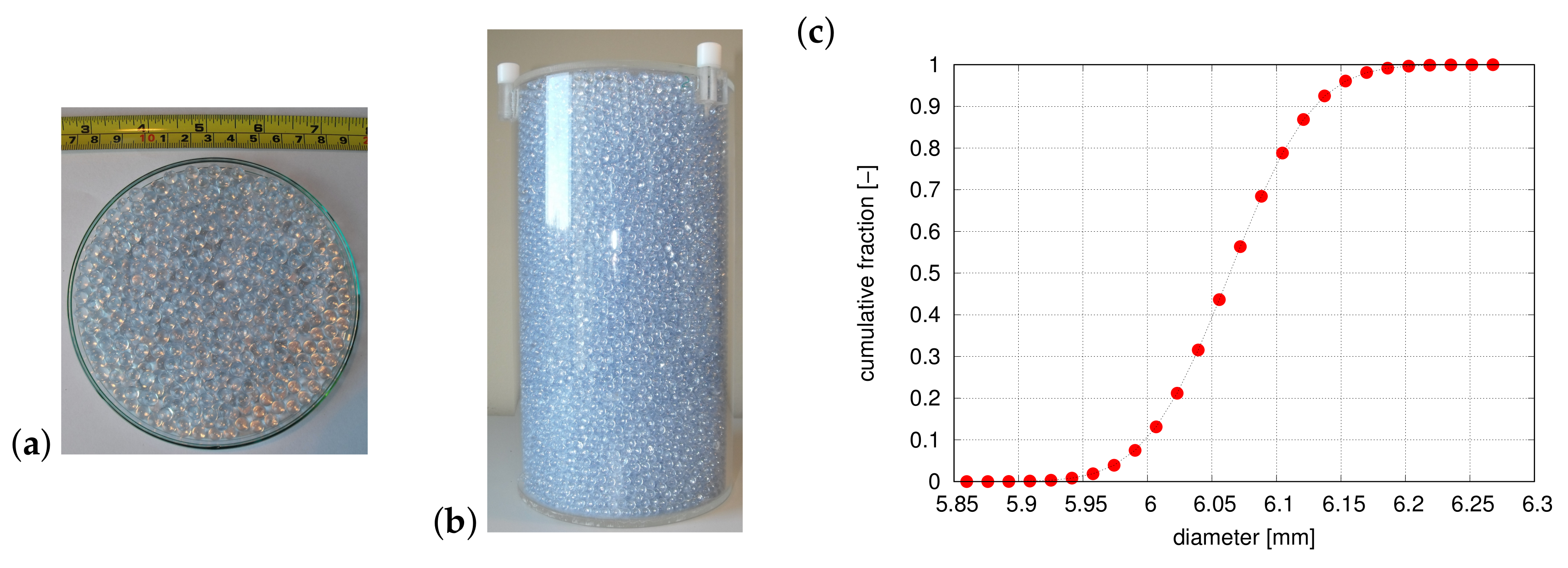
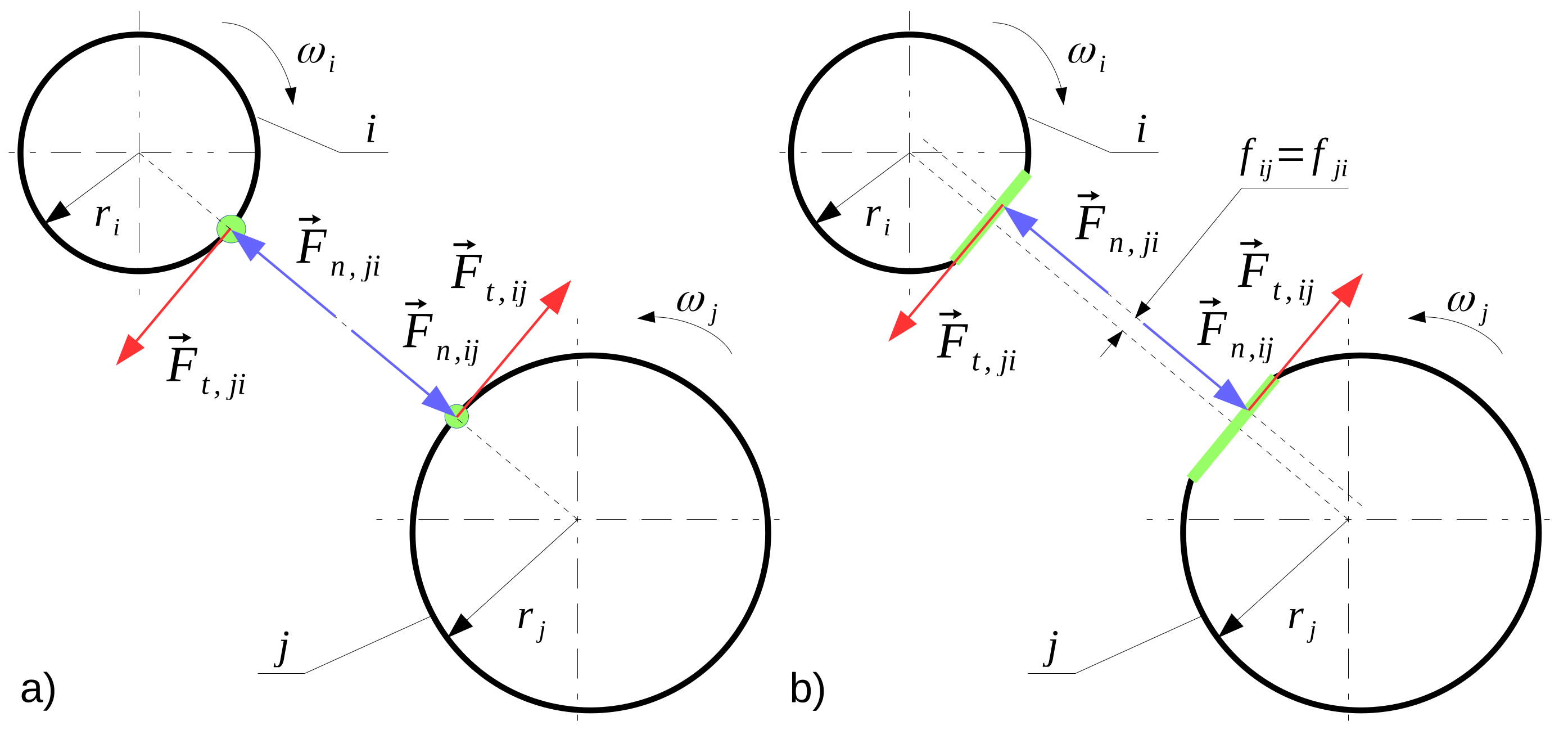
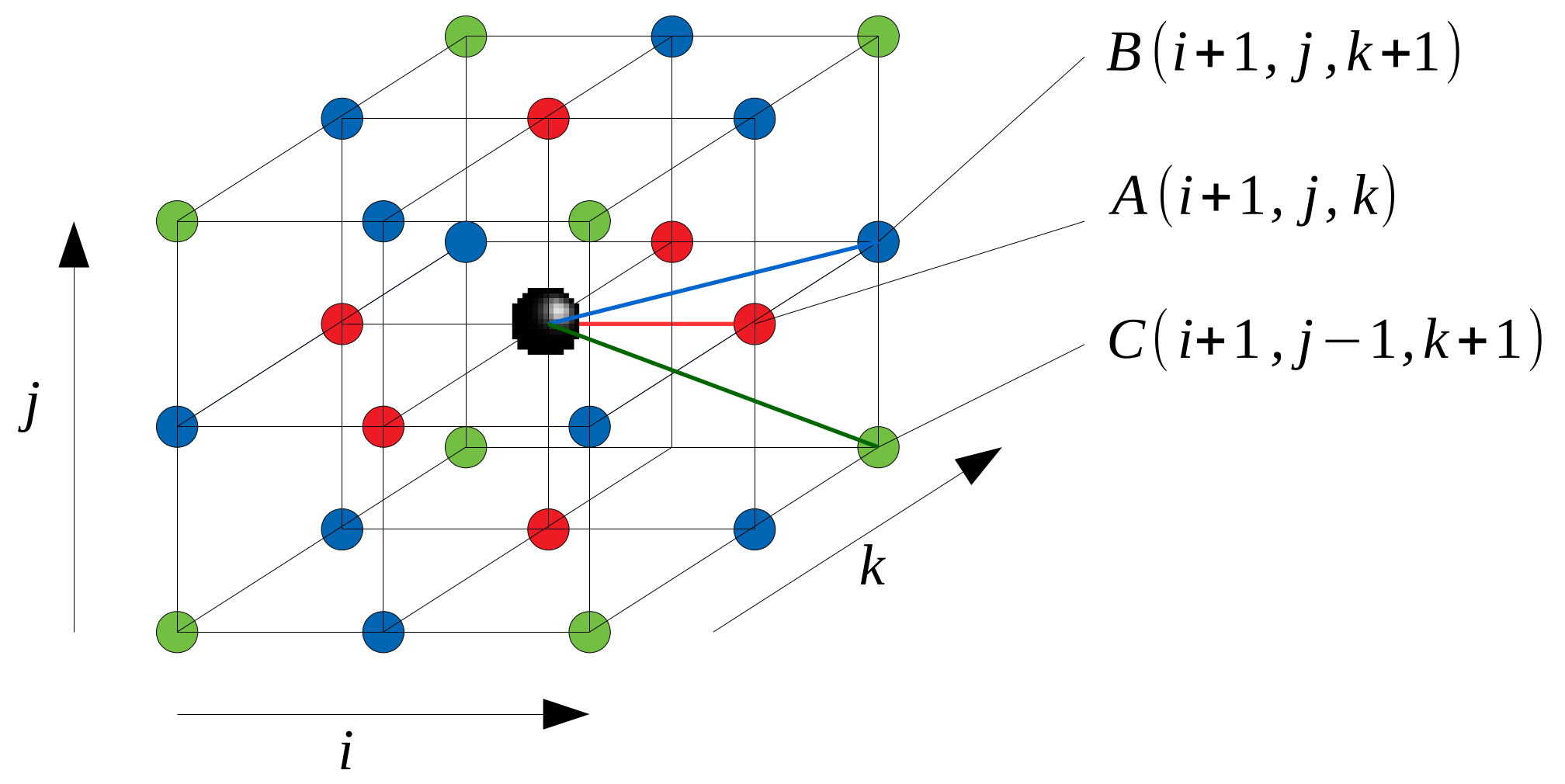

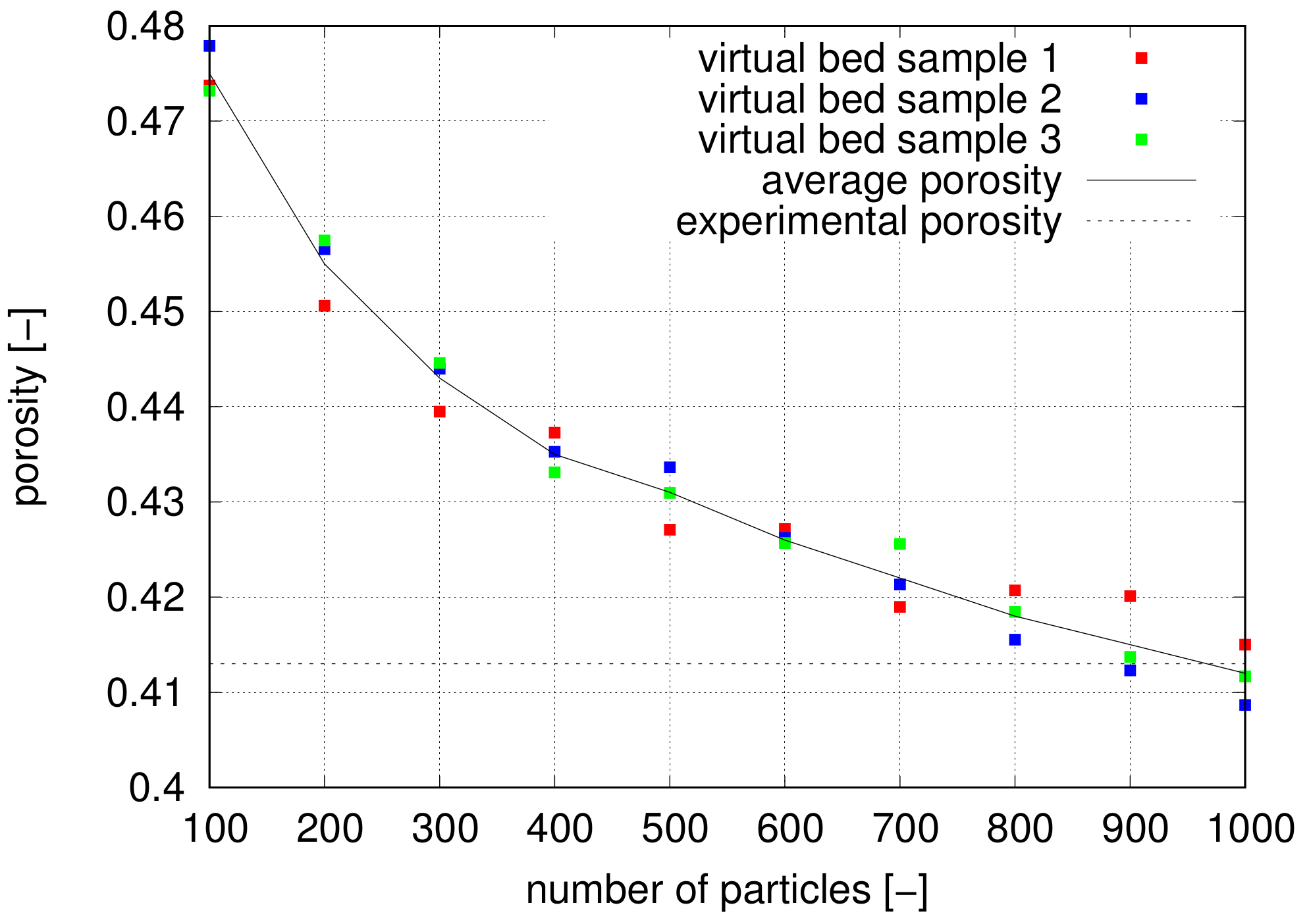
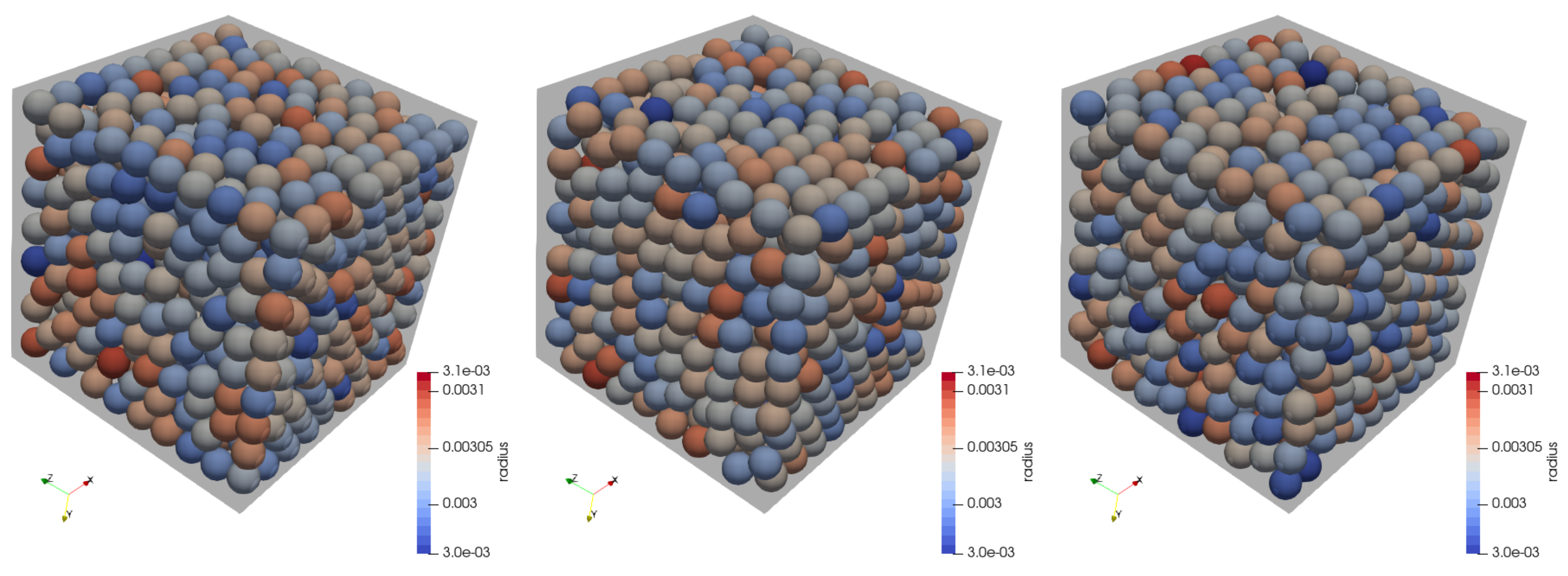



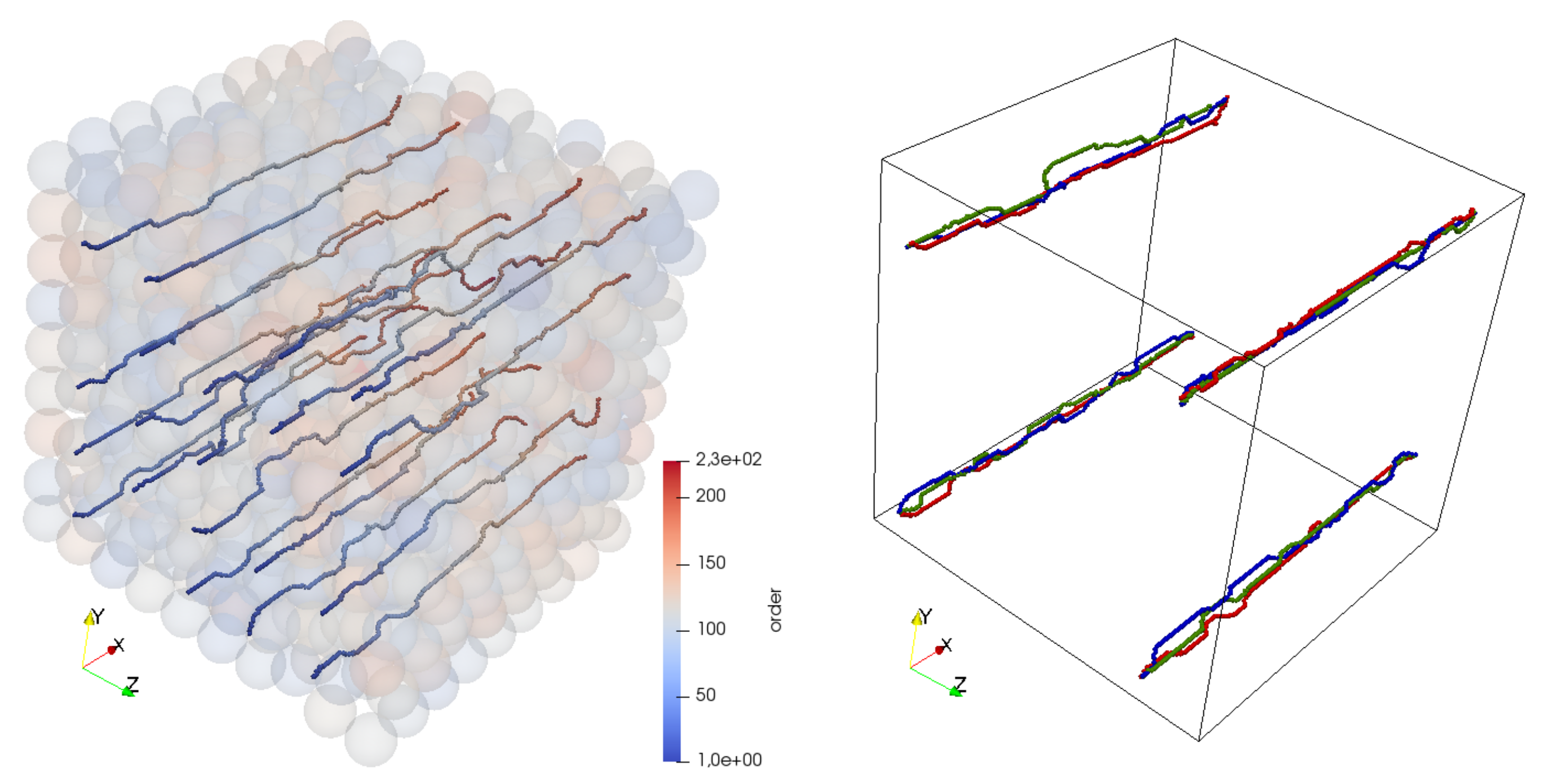
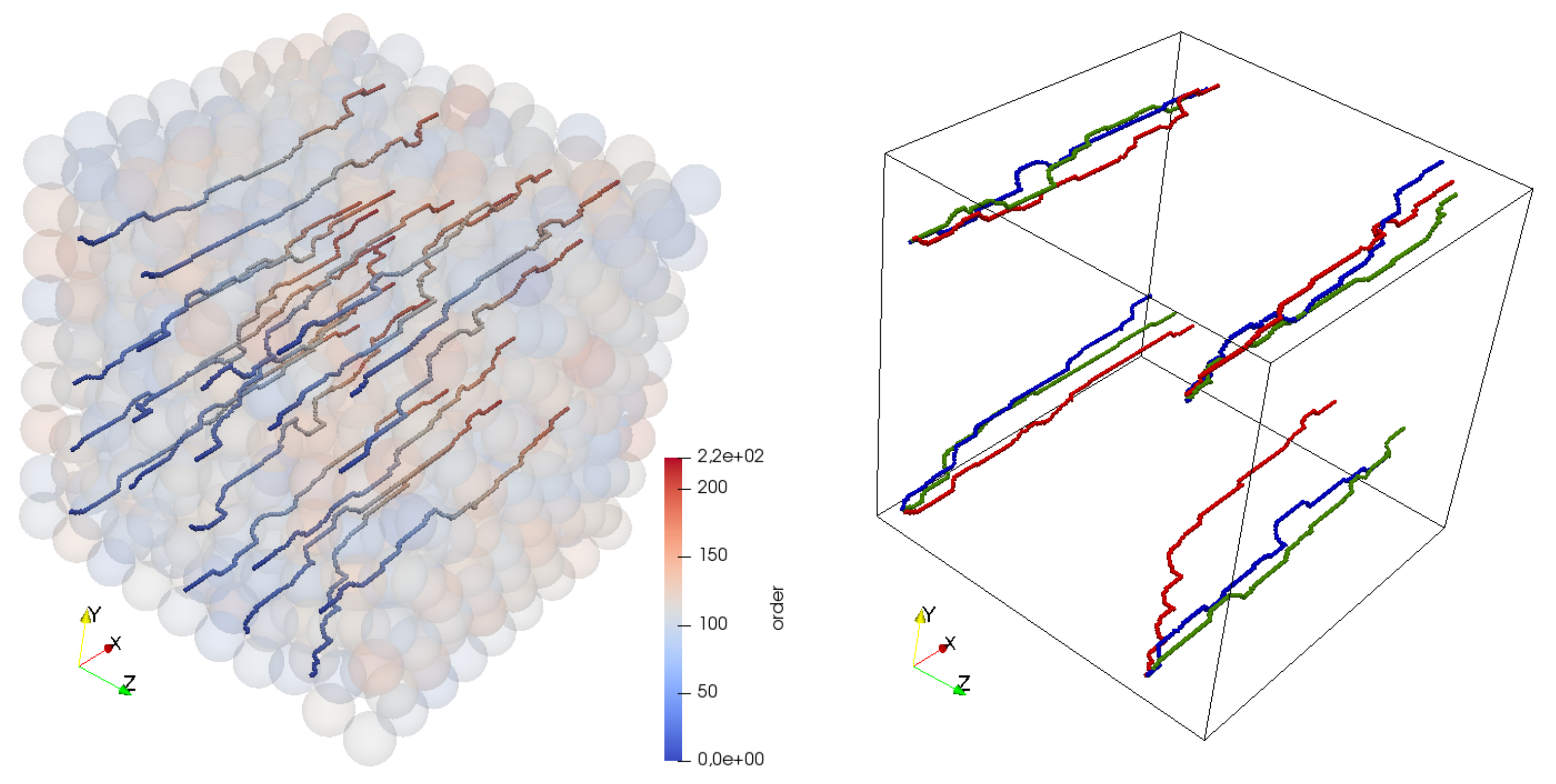
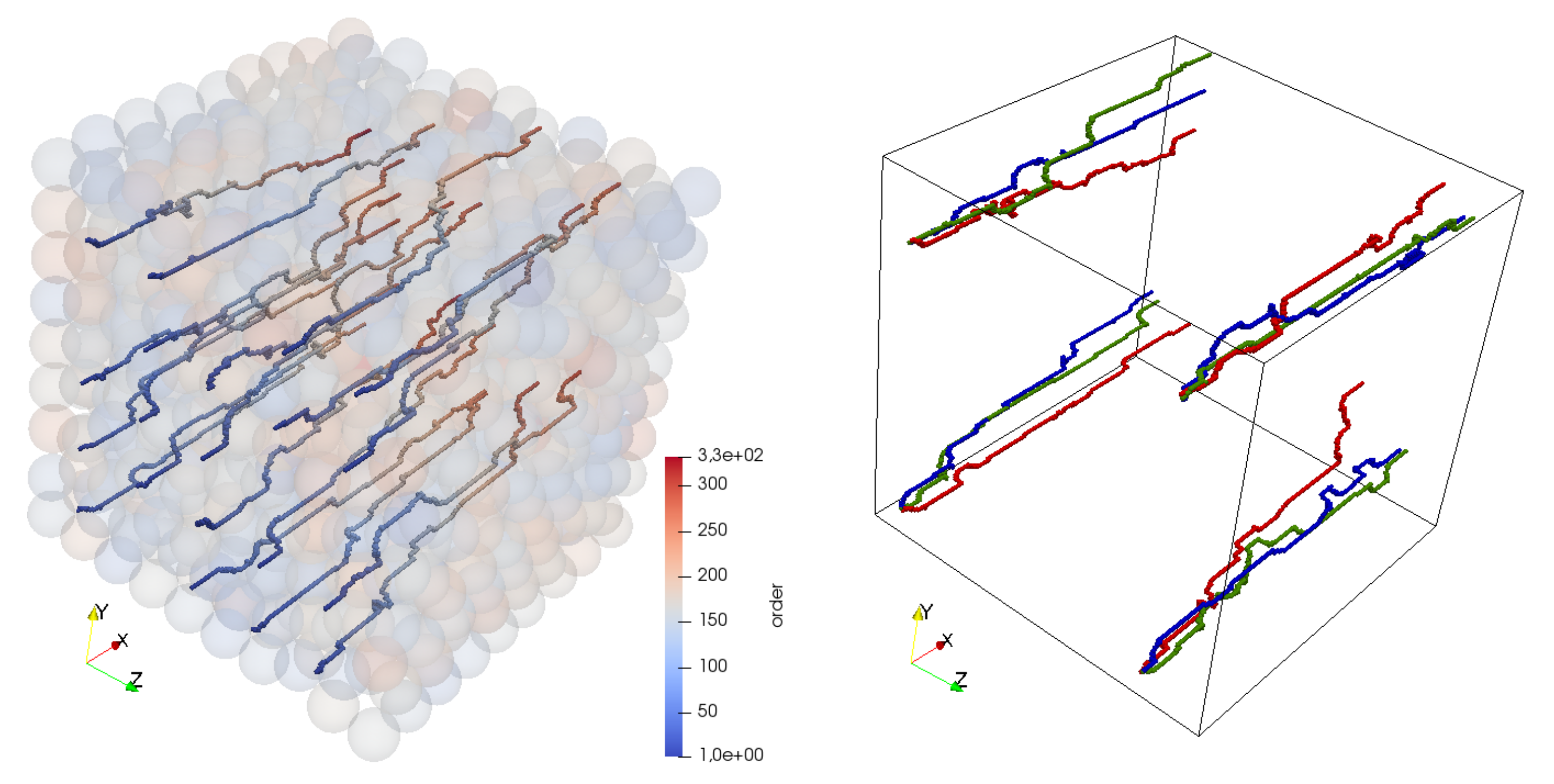



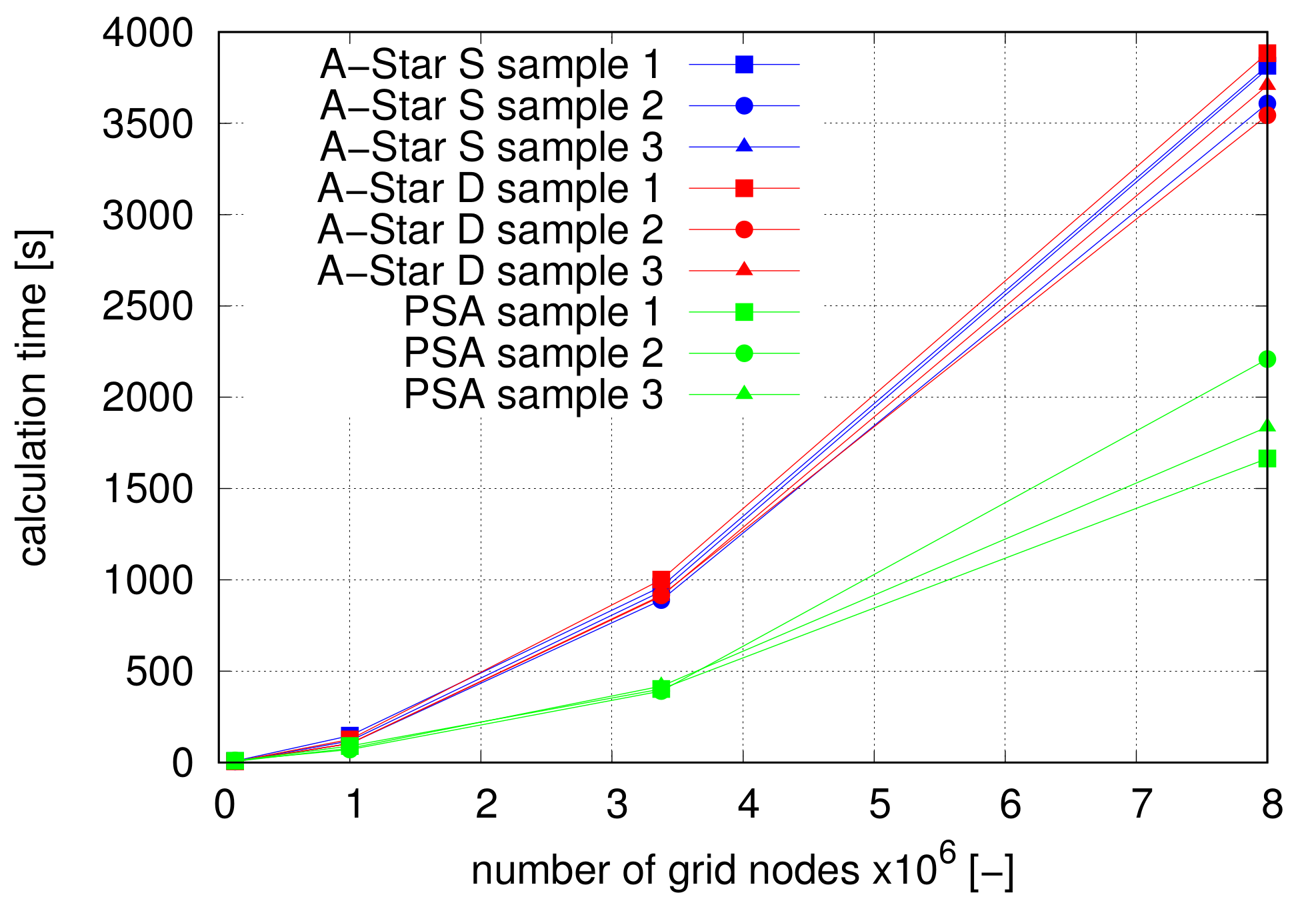


| No. | Source | Formula | |
|---|---|---|---|
| 1 | Bartell & Osterhof (1928) [28,29] | ||
| 2 | Carman (1937) [4,5] | ||
| 3 | Weissberg (1963) [28,30] | 1.4333 | |
| 4 | Du Plessis & Masliyah (1988) [28,30] | 1.3816 | |
| 5 | Comiti & Renaud (1989) [28,30,31] | 1.3626 for [29] | |
| 6 | Boudreau (1996) | 1.6639 | |
| 7 | Lanfrey et al. (2010) [29] | , where k is a shape factor | 1.4638 for |
© 2020 by the author. Licensee MDPI, Basel, Switzerland. This article is an open access article distributed under the terms and conditions of the Creative Commons Attribution (CC BY) license (http://creativecommons.org/licenses/by/4.0/).
Share and Cite
Sobieski, W. Calculating the Binary Tortuosity in DEM-Generated Granular Beds. Processes 2020, 8, 1105. https://doi.org/10.3390/pr8091105
Sobieski W. Calculating the Binary Tortuosity in DEM-Generated Granular Beds. Processes. 2020; 8(9):1105. https://doi.org/10.3390/pr8091105
Chicago/Turabian StyleSobieski, Wojciech. 2020. "Calculating the Binary Tortuosity in DEM-Generated Granular Beds" Processes 8, no. 9: 1105. https://doi.org/10.3390/pr8091105
APA StyleSobieski, W. (2020). Calculating the Binary Tortuosity in DEM-Generated Granular Beds. Processes, 8(9), 1105. https://doi.org/10.3390/pr8091105






